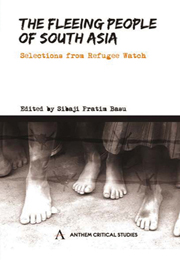Book contents
- Frontmatter
- Contents
- Acronyms and Abbreviations
- Foreword by Ranabir Samaddar
- Preface
- ETHICAL ISSUES
- LAWS
- SOUTH ASIA
- Introduction
- Refugees in South Asia: An Overview
- Internally Displaced Persons in Sri Lanka
- A Matter of Ethnicity
- Scrutinizing the Land Resettlement Scheme in Bhutan
- The Taliban Shelter Seekers or Refugee Warriors?
- Afghan Refugees head for Tajikistan, holed up in the Pamir Mountains
- Impact of International Jurisdiction on Afghan Refugee Rights
- Development Induced Displacement in Pakistan
- On the Trail of Burma's Internal Refugees
- Assault on Minorities in Bangladesh: An Analysis
- Neoliberal Globalization and Women's Experiences of Forced Migrations in Asia
- Who Went Where and How are They Doing? Pakistanis and Indians Outside South Asia
- INDIA
- GENDER
- INTERVIEW/CORRESPONDENCE
- REPRESENTATIONS
- Index
Internally Displaced Persons in Sri Lanka
from SOUTH ASIA
Published online by Cambridge University Press: 05 March 2012
- Frontmatter
- Contents
- Acronyms and Abbreviations
- Foreword by Ranabir Samaddar
- Preface
- ETHICAL ISSUES
- LAWS
- SOUTH ASIA
- Introduction
- Refugees in South Asia: An Overview
- Internally Displaced Persons in Sri Lanka
- A Matter of Ethnicity
- Scrutinizing the Land Resettlement Scheme in Bhutan
- The Taliban Shelter Seekers or Refugee Warriors?
- Afghan Refugees head for Tajikistan, holed up in the Pamir Mountains
- Impact of International Jurisdiction on Afghan Refugee Rights
- Development Induced Displacement in Pakistan
- On the Trail of Burma's Internal Refugees
- Assault on Minorities in Bangladesh: An Analysis
- Neoliberal Globalization and Women's Experiences of Forced Migrations in Asia
- Who Went Where and How are They Doing? Pakistanis and Indians Outside South Asia
- INDIA
- GENDER
- INTERVIEW/CORRESPONDENCE
- REPRESENTATIONS
- Index
Summary
INTRODUCTION
Throughout the years since 1983 in which military conflict between the Sri Lankan security forces and the Tamil militant groups has been the order of the day, we have witnessed a never-ending saga of a people forced into nomadic existence fleeing the areas of active conflict in search of a more secure and settled existence. Initial displacement of persons was a result of anti-Tamil campaigns in the southern parts of Sri Lanka in 1958, 1977 and 1978, which forced many Tamils to leave their homes in the Sinhala dominated parts of the country and move to the north and in the plantation areas in the late 1970s. Many of these people from the central highlands of Sri Lanka settled in the Vavuniya and Kilinochchi Districts of the Northern Province. Muslim and Sinhalese people living in Tamil majority areas have also been forced to leave due to threats against them.
[…] The question of Internally Displaced Persons (IDPs) in Sri Lanka is one of the main challenges for the humanitarian and human rights communities.
CATEGORIES OF IDPs IN SRI LANKA
The IDPs can at present be categorized under different headings to get a clearer understanding of the problem and the extent of resultant suffering, namely:
IDPs living in government controlled areas in the North and the East;
Internally displaced Tamils living in the North and East in territories held by the militants;
[…]
- Type
- Chapter
- Information
- The Fleeing People of South AsiaSelections from Refugee Watch, pp. 150 - 158Publisher: Anthem PressPrint publication year: 2009



